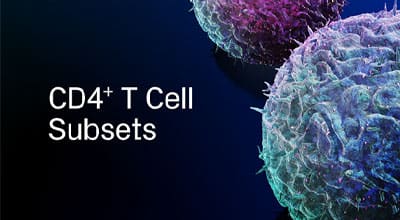Th17 Differentiation Pathway
Click on one of the links shown in the Explore Pathways box below to see the processes that promote Th17 differentiation and the transcription factors, secreted molecules, and some of the cell surface markers that distinguish a differentiated Th17 cell from the other T helper cell subtypes.
Use our Product Suggestion form to enter a request.
You will be notified once it becomes available.
Use our Product Suggestion form to enter a request.
You will be notified once it becomes available.
chain
chain
(human)
(human)

Overview of Th17 Differentiation Pathways
Upon TCR activation, naive CD4+ T cells differentiate into one of several T helper cell lineages depending primarily on cytokines present in the surrounding environment. Each T helper cell subset expresses a unique set of cell surface markers and transcription factors, and secretes a defined array of cytokines that determines its functional properties. Th17 cells are required for immune responses to specific extracellular bacteria and fungi. In mice, naïve CD4+ T cells differentiate into T helper type 17 (Th17) cells in the presence of TGF-beta and IL-6. These cytokines establish early commitment to the Th17 lineage by activating STAT3, which induces the expression of IL-21. Autocrine signaling by IL-21 promotes STAT3-dependent expression of IL-23 R, IL-17A, and the transcription factor, ROR gamma t. IL-23 R heterodimerizes with IL-12 R beta 1 to form a functional IL-23 receptor, which in the presence of IL-23, maintains STAT3-dependent expression of IL-23 R, ROR gamma t, and IL-17A to stabilize the Th17 phenotype. ROR gamma t is considered to be the master transcriptional regulator of Th17 cells due to its ability to drive the expression of IL-17A, IL-17F, and IL-22, three hallmark cytokines secreted by Th17 cells. These cytokines stimulate the expression of secondary pro-inflammatory mediators and anti-microbial peptides. Additional transcription factors that have been suggested to be involved in Th17 differentiation include ROR alpha, Batf, and IRF4, which along with ROR gamma t, may also control IL-17 gene expression. In contrast to mouse Th17 differentiation, differentiation of human Th17 cells requires IL-6, IL-21, IL-23, and IL-1 beta, but may be less dependent on TGF-beta. One other notable difference is that in addition to IL-17A, IL-17F, and IL-22, human Th17 cells secrete IL-26, an IL-10 family cytokine without a murine homologue. Although cytokines secreted by Th17 cells play an important role in eliminating harmful microbes, unregulated expression of these cytokines may also contribute to the pathogenesis of a number of autoimmune diseases, including rheumatoid arthritis, multiple sclerosis, and inflammatory bowel disorders.
To learn more, please visit our Th17 Cells Research Area.
Get Print Copy of this Pathway






